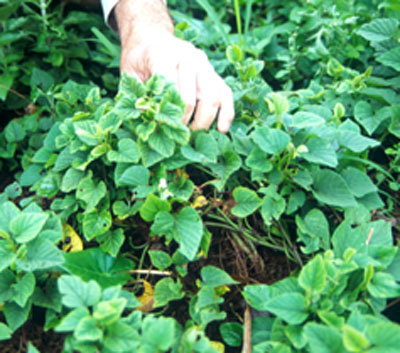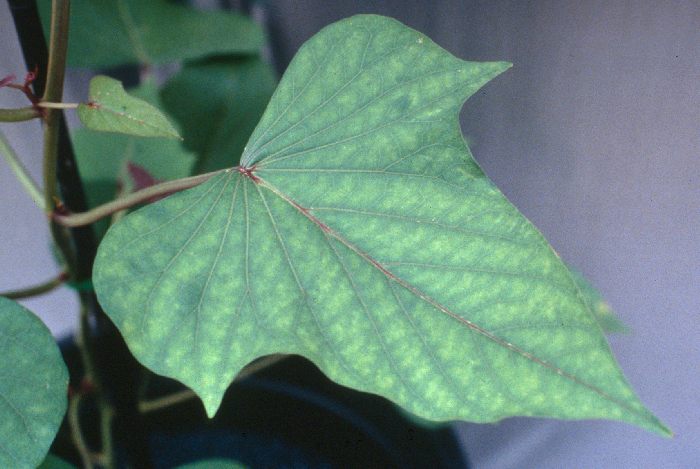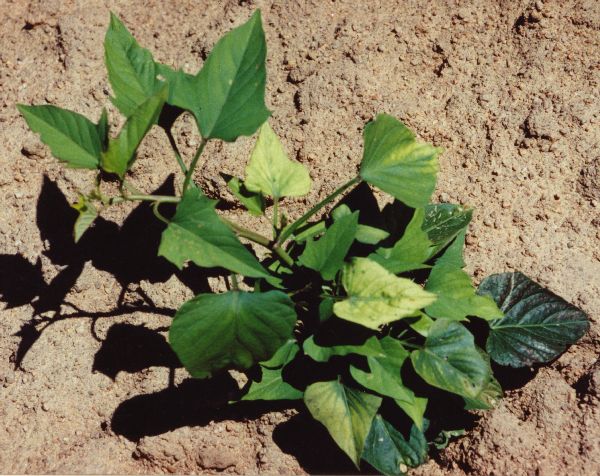|
Zinc (Zn) deficiency may occur on acidic soils which are low in zinc, or on alkaline
soils in which the solubility of zinc is reduced. Due to the declining
availability of zinc with increasing soil pH, applying lime or dolomite to acid
soils may induce zinc deficiency. Applications of copper fertiliser, or large
amounts of phosphorus fertiliser, may also exacerbate zinc deficiency.
Crops vary considerably in their
sensitivity to zinc deficiency. Sweetpotato appears to be of moderate
sensitivity, and is less susceptible than, for example, cassava or citrus. These
species may provide good indicators, if present in the vicinity of a sweetpotato
crop suspected of zinc deficiency, as they develop clear and distinctive
symptoms in situations where symptoms on sweetpotato are mild or not evident.
Sweetpotato seems to suffer most severely
from zinc deficiency at early stages of establishment, and in cool weather. It
is common for the crop to “grow out of it”, or to recover as the season
warms. However, the effect on final yield of an early zinc stress has not been
determined.
The most distinctive symptom of zinc
deficiency in sweetpotato is a reduction in the size of young leaves.
The leaves are thickened but usually not distorted, and may be as small as 1-3
cm in length. After the onset of this symptom, plant growth is severely limited.
In some cultivars, internodes are also shortened, but in others this occurs to a
far lesser extent than the reduction in leaf size. General chlorosis of the
young leaves is usual, but may vary from mild to almost complete bleaching.
Increased purple pigmentation of the shoot tips may occur in some cultivars.
Characteristic changes in leaf shape are narrowing of the blade, and
repositioning of the lateral lobes (if present) to point towards the leaf
tip more acutely than normal.
Interveinal chlorosis on mature leaves is
often the first sign of zinc deficiency, preceding obvious symptoms in the young
leaves. However, in some cultivars it may not appear at all. The pattern of
chlorosis is diffuse (fading gradually with distance from the veins), and minor
veins retain green pigment to some extent, giving the leaf a mottled
appearance.
It has been reported that the storage
roots of zinc-deficient sweetpotato plants are of normal shape and size, but may
display a brown discolouration of the flesh.
The appearance of a fine interveinal
mottle on mature leaves may be mistaken for early signs of potassium deficiency.
On potassium-deficient plants, however, the oldest leaves are usually the most
affected, and leaves do not respond to painting with zinc sulfate.
Some cases of zinc deficiency may be
mistaken for iron deficiency. However a number of distinguishing features will
be evident. With zinc deficiency, chlorosis on older leaves is more diffuse,
while in iron deficiency, the veins contrast sharply with the interveinal
tissue. In young leaves, the change in leaf shape and thickening of the leaf
blade are not observed in iron deficiency, and necrosis of young leaves or the
shoot tip is not typical of zinc deficiency. Again, leaf painting may be used to
separate the two deficiencies.
Little leaf, or witches’ broom, is a
disease of sweetpotato caused by a mycoplasma-like organism. Affected plants
have small, thickened and sometimes chlorotic young leaves which may be mistaken
for zinc deficiency. As it rarely affects all the plants in a plot, the
observation of healthy plants adjacent to severely stunted, small-leaved plants
indicates little-leaf, while zinc deficiency tends to affect adjacent plants
similarly. Little-leaf also induces proliferation of side shoots from leaf
axils, and latex is absent from cut stems or roots. Symptoms of little-leaf
often appear or intensify following a dry period.
Suspected cases of zinc deficiency can be
confirmed by a positive response to painting the leaf surface with a solution of
0.5% zinc sulfate plus 0.25% calcium hydroxide. Normally, one half of a leaf
blade is painted, so the response can be compared directly with the untreated
half. After a few days, this should result in regreening of chlorotic tissue on
either mature or young leaves, and may increase expansion of the treated area of
young leaves. It is important to label the painted leaf clearly so that it can
be identified on later inspection.
A critical leaf concentration of 11 mg
Zn/kg was determined in experiments using solution culture (7th to 9th
youngest leaf blades at 4 weeks). However, field data suggest that this
underestimates the actual critical concentration. A concentration of 17 mg Zn/kg
was associated with severe symptoms in young plants growing on granitic sand in
northern Australia. These plants responded positively to leaf painting with zinc
sulfate solution. Data from other sweetpotato crops in the same region suggest
that the critical concentration may lie between 20 and 30 mg Zn/kg, and may
increase with age of the crop. Leaf analyses from crops in a wide range of
situations indicate a normal range of approximately 30 - 60 mg Zn/kg.
Various extractants have been used to
estimate plant-available zinc in soils, including hydrochloric acid, dithizone
and DTPA. These tests are influenced to varying degrees by the soil pH, free
lime content and phosphate concentration, and reported critical concentrations
for zinc deficiency in a range of crops vary widely (1.0-7.5 mg Zn/kg with
hydrochloric acid, 0.3-2.3 mg Zn/kg with dithizone). An extractant containing
0.01 M EDTA and 1 M ammonium carbonate has been found to be suitable over a
range of soils, including alkaline, calcareous soils (Trierweiler and Lindsay,
1969). Using this test, a critical concentration of 1.4 mg Zn/kg was determined
for Zn deficiency in maize, a crop regarded as being sensitive to low Zn supply.
Foliar spraying is probably the most
convenient method of supplying zinc to a zinc-deficient crop, and is
particularly recommended on alkaline soils, where soil-applied zinc may have low
availability. Rates for sweetpotato have not been optimised, but guidance may be
taken from the rate used for ginger (0.5% zinc sulfate heptahydrate with 0.25%
calcium hydroxide) and cassava (1-2% zinc sulfate heptahydrate solution).
On neutral and acid soils where zinc
deficiency is known to occur, soil application at or before planting is likely
to be more effective than foliar sprays after crop establishment. Soil
application rates of 3-10 kg Zn/ha as zinc sulfate heptahydrate (23% Zn) or zinc
oxide (60-80% Zn) are typical for vegetable crops. The lesser amount may suffice
on light-textured acidic soils, whereas clayey soils may require the higher
amount. Zinc oxide should be broadcast and incorporated into the soil before
planting. Zinc sulfate heptahydrate is more soluble, and band application at the
time of planting is acceptable. Zinc applications may be effective for several
years.
Prevention of zinc deficiency during
establishment of cassava has been achieved by dipping the cuttings in 2-4% zinc
sulfate solution for 15 minutes prior to planting. A similar strategy may be
effective with sweetpotato cuttings.
Burying small pieces of scrap galvanised
iron in the mound or ridge may provide an effective source of zinc to the crop.
This is a particularly useful strategy where zinc fertilisers are not available
or are poorly effective due to high alkalinity of the soil.
Maintenance of a high soil organic matter
content increases the availability of zinc to plants.
Asher, C.J. and Lee, M.T. 1975. Nutritional disorders in ginger. Department of
Agriculture, University of Queensland, St. Lucia.
Asher, C.J., Edwards, D.G. and Howeler, R.H. 1980.
Nutritional disorders of cassava. Department of Agriculture, University of
Queensland, St. Lucia.
Chapman, H.D. 1966. Zinc. In: Chapman, H.D. (ed.) Diagnostic
criteria for plants and soils. Dept of Soils and Plant Nutrition, University of
California Citrus Research Centre and Agricultural Experiment Station,
Riverside, California.
Clark, C.A. and Moyer, J.W. 1988. Compendium of Sweet Potato
Diseases. APS Press, The American Phytopathological Society, St. Paul, USA.
Landon, R.J. 1991) (ed.) Booker tropical soil manual: a
handbook for soil survey and agricultural land evaluation in the tropics and
subtropics. Booker Tate Ltd; Longman, London.
Olsen, S.R. 1972. Micronutrient interactions. In: J.J.
Mortvedt, P.M. Giordano and W.L. Lindsay (eds.), Micronutrients in Agriculture.
Soil Science Society of America Inc., Madison, Wisconsin, USA, pp 243-264.
O’Sullivan, J.N., Asher, C.J. and Blamey, F.P.C. 1997.
Nutrient Disorders of Sweet Potato. ACIAR Monograph No. 48, Australian Centre
for International Agricultural Research, Canberra, 136 p.
O’Sullivan, J., Loader, L., Asher, C., Blamey, P. 1997b.
Troubleshooting nutritional problems in a new industry: sweet potato in North
Queensland. Proceedings of the First Australian New Crops Conference, Gatton,
July 1996. Rural Industries Research and Development Corporation, Australia.
Trierweiler,
J.F. and Lindsay, W.L. 1969. EDTA-ammonium carbonate soil test for zinc. Soil
Science Society of America Proceedings 33, 49-54.
Contributed by:
Jane O'Sullivan |
Characteristics
and occurrence
Symptoms
Confusion
with other symptoms
Diagnostic
tests
Management
References

Reduction in leaf size and leaf yellowing on
Zn-deficient crop in Tonga (J.
O'Sullivan).

Fine interveinal chlorotic mottle on a mature leaf (J.
O'Sullivan).

Severe deficiency may lead to dramatic reduction in
leaf size and shortening of internodes (J.
O'Sullivan).

Extreme miniaturization of new leaves with shortening of internodes
(J. O'Sullivan).

A young plant showing recovery from Zn-deficiency due to warmer
weather, with larger green leaves above the small, chlorotic leaves (L.
Loader).

Reduction in leaf size of four cultivars due to Zn deficiency, compared
with healthy leaves (bottom) (J. O'Sullivan). |

